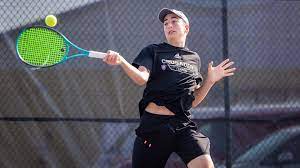1. Set Up
If you want to learn how to play volleyball, the first step is setting up the court. He of the same size needs two teams. One team should stand behind the net and the other team should stand on the other side of the field. The goal of each team is to score points by hitting balls over the net.
Hand Position and Technique
Bring your hands together.
1.Bring your hands together so that your fingertips are touching.
2.Open your hand and form a triangle with your index finger and thumb.
3.Spread your fingers to the perfect distance to place the ball.
4.This is where he wants to put his hand just before touching the ball setting.
Finding Hand Position
To find the set position for volleyball, place your hands on your head with your index fingers and thumbs together.
1. Bring your hands together
2. Open your arms
3. Fingers Forming the Ball
4. Final Position
When setting up a volleyball, touch the ball only with your fingers, not with your palms. The finger contact point should be near the same contact point that formed the triangle (essentially the fingertip should be on top of the ball).
The ball is touched with the same force with his thumb and his first two fingers, and the force with which his last two fingers of both hands touch the ball is much less.
Stake Tip
Rotating the ball after seeding is a good sign that you are not touching the ball cleanly.
Look at the text and see if it rotates.If you get into the habit of betting without adding spin to the ball, you are unlikely to get called with a double touch.
Generally, volleyball players who are slow to place the ball tend to have more fingers on the ball.
This additional extended contact gives you more control for more precise placement of settings. Also, longer contact can take more spin from the ball, helping to avoid double-hit ball-handling calls.
On the other hand, the more fingers you touch the ball, the more likely you are to double-touch it.
With short contact times, you won’t even be asked to lift the ball.
The quick set style and the slow set style each have their pros and cons. We recommend experimenting with different speed and style settings to see what works best for you.
2. Ball Handling
The second step is ball handling. Each player must hold the ball between their legs and keep their arms straight. As they move forward, they have to push off the ground with their feet. If you want to pass the ball, you have to throw it toward the opposing team.
Ball handling is a key component of volleyball
Proper ball handling is essential to a good volleyball game. A volleyball player must be able to accurately control and shoot the ball for his team to win.
His ability to handle the ball quickly and decisively gives his team an advantage on the pitch. Practice makes perfect, so don’t let being bad at the ball stop him from becoming a better volleyball player.
There are many ways to improve your ball-handling skills. So find what works best for you and get started.

Ball Has Multiple Points of Legal Contact
Volleyball is a sport where players must make multiple points of legal contact with the ball in order to maintain possession and control of it. Players must be able to handle the ball quickly and accurately
while standing, with practice and experience.
Ball has a number of legal contact points, each with specific rules that must be followed during play. In volleyball, ball handling is important for both offense and defense. Without them, a team can struggle to succeed on the pitch.Whether you’re a beginner or a veteran, good ball handling can help you excel in this exciting sport.
Players Must Keep Hands on the Ball
Volleyball is a sport in which two teams attempt to kick the ball over the net using their hands and feet. Players must keep their hands on the ball at all times, no matter what else they are doing.
If a player loses control of the ball, that player and his team lose the game. Ball-handling mistakes can lead to huge losses in a volleyball game, so players need to stay focused all the time. The best way to improve your volleying skills is to practice regularly with your coach and teammates. This will give you better control of the ball.
Whether you’re kicking, passing or serving, it’s important to keep control of the ball at all times. Volleyball is an aerial sport that requires a lot of stamina and coordination. Don’t forget your feet.
Help your team win by practicing until you perfect your ball-handling technique.
3. Spiking
The spike is the third step in volleyball. To spike the ball, the player must jump and kick the ball toward the opponent’s side of the net. Players should aim to get the ball over the net.
Volleyball Spike Approach
Which player on the team does the volleyball attack?
To legally spike the ball when it is in the net, you must be a front-row player. So usually only the front
row players of the team attack the ball.
Back row players may legally jab the ball from behind the 3-meter (10-foot) line. This is a much more difficult type of volleyball attack, used only by more experienced volleyball players.
Classic basic spikes are made by jumping from both feet. Spikers typically attack the ball in a series of steps. These steps are called volleyball approaches.
The goal of the volleyball approach is to get the best position possible to attack the ball.
When teaching a player to approach and hit a volleyball, the last two steps he can begin to learn. After mastering the last two steps, you can complete a 3 or 4-step volleyball approach.
The Last Steps
When you first learn to spike, focus on the last steps to time your shots.
l For a right-hander, the last steps are the right foot, then the left foot and so on (up to 4 steps).
l For a left-hander, his last steps are his left foot, then his right foot and so on (up to 4 steps).
Contact Point
You must touch the ball with your arms and elbows up. Contacts should be directly above or slightly in front of the body. The ball is touched with a wrist-snapping motion to direct the ball into the opponent’s court.
The trajectory of The Set
Set trajectory has different ways of attaching volleyball spikes. When attacking an outbound ball, a volleyball attacker can attack diagonally from outside the court. This angled approach to volleyball prepares the attacker to effectively hit the ball at difficult angles or spin to hit the ball over the line.
4. Serving
The serve is the fourth step in volleyball. A player must serve by throwing the ball toward the opposing team. You have to make sure the ball goes over the net.
Types of Serves in Volleyball
Underhand Serve
The underhand serve is the easiest to teach because it has few variables. The underhand serve is easy to learn and control as there is no throw involved.
Here are some basics for learning a right-handed underhand serve.
1. Step your feet back and forth and shift your weight behind your right foot.
2. The ball is held in the left hand in front of the right hip and in front of the body just below the hip.
3. Lean your shoulders and upper body slightly forward.
4. Notice the contact point of the ball.
5. Contact the ball with the flat part of the fist and the area of the palm/pointer/thumb.
6. Swing your right arm back and forth like a pendulum.
7. Now shift your weight onto your front foot as you swing your arm to touch the ball.
8. Contact just below the equator centered on the ball.
9. Left-hand falls just before contact.
10. Continue chasing the ball to the target after contact.
Overhand Serve
When learning to serve in volleyball, you need to learn the technique of the overhand serve. The overhead serve is the most popular serve in high school and college. The two main serves from the upper hand are topspin and float.
An overhand serve is more difficult to overtake than an underhand serve.
A hand serve is like throwing a ball.
The cues used in the overhand serve are toss and draw, step and swing.
Here are the basics for learning a right-handed overhand serve.
1. Start with a back-and-forth step with most of your weight behind your right foot.
2. The left hand stretches the volleyball forward and holds it in front of the right.
3. The shoulder is forward, and the right shoulder is dropped back.
4. Throw the ball forward right.
The throw is a very important part of the volleyball serve. Servers should throw the ball with a lifting motion and should not lean forward or drop their left hand.
5. Defense
The fifth step in volleyball is defense. In defense, players should try to stay close to the net and block the ball. Don’t spread the ball too wide.
6. Running
Running is the sixth step in volleyball. After hitting the ball, the player must walk around the field and try to return to his original position.
7. Picking Up
Picking up is the seventh step in playing volleyball.When a player misses the ball, he or she should pick it up and return it to the field.
Conclusion
That was all for today. We hope you learned something new from our article. Here is a quick outline for review:
1. Set Up
2. Ball Handling
3. Spiking
4. Serving
5. Defence
6. Running
7. Picking Up
That’s it! Now you’re ready to jump into the court, aren’t you?
Wishing you best of luck on your journey! Kudos!





